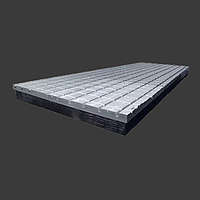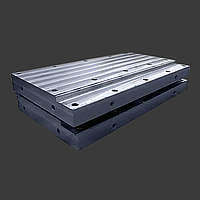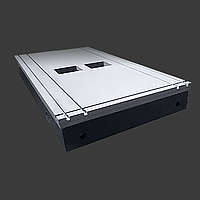Foundry manager Florian Lorenz uses a stylus to make the final settings on the blasting machine's control panel while a casting plate weighing several tons is slowly lowered onto the conveyor belt. The employee is concentrating on positioning the casting with millimeter precision. In a few minutes, the plate will demonstrate that the blasting process in the foundry is now much more efficient and precise than in previous decades. Not only the boss Martin Stolle is on site for the inauguration of the plant, but AGTOS - as the manufacturer of the plant - has also arrived with a camera team to record the special moment.
The components, which weigh up to 25 tons, are produced here at the Bonn foundry Wilhelm Stolle GmbH, which specializes in the construction of special machines. The precision parts later find their way into the automotive industry, machine construction or are used in measuring and testing technology. In the coming year, the company will be looking back on 125 years of company history at its sites in Bonn Bad-Godesberg and Beuel. A total of almost 120 employees ensure that the components are later used worldwide.
For visitors, it is an unusual sight that presents itself in the machine hall. "Castings, for example, are processed with continuous overhead conveyor shot blast machines and other types of machines," says Ulf Kapitza, Head of Business Development & Marketing at AGTOS. "Here at Stolle, they decided to use a roller conveyor shot blast machine and that is something special for us as well." The machine takes up a good quarter of the hall space and can practically be operated by one person. Downstream, the quality assurance is also located here in order to precisely check the blasted parts before further processing.
Retrofit was not worthwhile
"We previously had a roller conveyor blast machine, but it was already almost 35 years old," explains Managing Director Martin Stolle. At that time, the design was already similar to the new AGTOS system and was specially developed for the needs of the foundry, as the special components also required an individual system design. "For the conditions at that time, the plant delivered very good results. However, you have to know that everything was previously brushed off by hand. The time saved by the blast machine was clearly noticeable." However, the old machine could not sufficiently clean the components in one pass and so the process had to be carried out three to four times.
"Moreover, the system could not manage completely without manpower, because after the blasting process, the abrasive had to be removed manually by the employees, which was sometimes only possible with shovels," adds Stolle. "After more than thirty years of operation, it was time to start thinking about a new acquisition. A retrofit would have been possible, but we still wouldn't have achieved a better blasting result. In addition, our quality requirements and those of our customers have developed considerably over the past decades. Therefore, it was time for a new system.
Ecology and economy were the focus
The newly installed roller conveyor blast machine from AGTOS is specially designed for the desanding of machine beds and tables and is capable of handling the high sand content in a short time. The parts can have a maximum dimension of 8000 x 3200 x 1000 mm (L x W x H). The system is designed so that the workpieces can be smooth at the top and cut in different geometric contours at the bottom. "The geometries and pockets of the workpieces are on the bottom," Kapitza explains.
"Therefore, there is a walkable foundation underneath the plant that houses many plant components. In addition, eight of the total of twelve turbines are also located here. They ensure the precise blasting result for the complex workpieces."
"The new plant does all this fully automatically," explains Stolle. "Above all, a single blasting process is now sufficient for 99 percent of our parts." This saves time, energy and personnel. "Of course, there are special custom parts that have to go through the system a second time due to their geometries - nevertheless, there is no comparison to before."
Operation of the roller conveyor shot blast machine
The workpieces are positioned on the roller conveyor by means of an overhead crane. After the start of the roller table, the workpieces actuate the sensor located in front of the infeed sluice for automatic blast media supply to the running high-performance turbines. This ensures that blasting only takes place when workpieces are in the blasting area. During the pass, the workpieces are blasted at all points accessible to the blast machine. The system is equipped with effective sound insulation so that a sound pressure level of only approx. 85 dB(A) is generated outside. The inlet sluice is equipped with wear-resistant rubber curtains for sealing. Sealing from below is provided by rubber seals.
The abrasive is removed by a powered brush and dust residues are blown off the castings by a high-power blower. The abrasive is kept circulating and cleaned for continuous use. Via the blast media metering device, the cleaned blast media passes from the blast media hopper to the high-performance turbines.
Characteristics of the installed turbines
- Number: 12 pieces
- diameter: 350 mm
- Number of blades: 6 pieces
- Driving power per turbine: 11 kW
Characteristics of installed filtration equipment
- type: 2x AGTOS PF 4b-32-NO-05-AB
- Volume flow: 24 000 m3/h
- Filter area: 256 m2
- Residual dust content with after-filter: 5 0, 15 mg/Nm3
Kapitza reports that the AGTOS blasting system has some special features compared to typical foundry systems: "Normally, a magnetic air classifier is installed in foundries for the separation of sand and abrasive. In this project, however, this was not desired by the customer. In this project, however, this was not desired by the customer, so we installed a normal air classifier and pass the abrasive through the air classifier several times by means of a bypass. For AGTOS, such special customer requests do not pose a problem.
"We also see ourselves as a special equipment manufacturer to a certain extent and take individual specifications into account during the project phase." Florian Lorenz adds: "Due to intensive consulting in the project phase, we had only a few changes afterwards. We were able to solve small issues very well. We stayed completely on schedule. The cooperation was again very good. When we had adjustment work, we could quickly access the AGTOS assemblers. Within a few hours, it was possible for someone to be with us and help us adjust processes, or still optimize the blast quality." With the new system, the Bonn-based company has modernized an important component in its energy- and time-consuming process chain and now considers itself flexibly positioned. "I could imagine offering blasting hours for customers in the future, who could then have their large parts made of steel or cast iron processed directly by us," says Stolle's reflection. "This would enable us to operate the plant even more economically."





